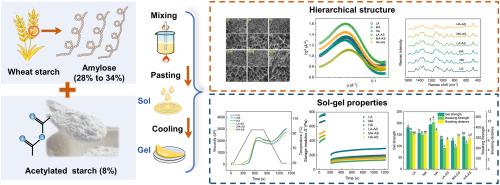加入乙酸化淀粉以定制基于中间筋小麦淀粉的二元基质的分层结构和溶胶-凝胶特征
IF 11
1区 农林科学
Q1 CHEMISTRY, APPLIED
引用次数: 0
摘要
乙酸盐淀粉(AS)是一种淀粉衍生物,由于其替代度低、储存稳定性好,经常被用作食品添加剂,以提高小麦淀粉(WS)的加工性能。本研究探讨了在小麦淀粉和乙酰化淀粉(WS-AS)二元体系中,乙酰化淀粉对不同淀粉含量的小麦淀粉的分层结构和溶胶/凝胶特征的影响,旨在阐明乙酰化淀粉的潜在实际应用。与 WS 相比,WS-AS 二元体系在冷却阶段的后退值、凝胶强度、硬度、零剪切粘度和模量明显降低,同时 WS 的溶胶-凝胶转变受到抑制。二元体系中相对升高的半最大全宽 FWHMλ480 值(从 19.52(低直链淀粉,LA)-23.63(中间直链淀粉,MA)升至 23.54(LA-AS)-26.26(LA-MS))证明了这一现象的合理性。此外,傅立叶变换红外光谱(FTIR)分析表明,AS 的加入产生了一种添加效应,表现出截然不同的影响。随着 WS 中直链淀粉含量从 28% 增加到 34%,溶胶的模量和粘度以及触变性都会增加,从而使凝胶具有更高的强度和更强的咀嚼性。因此,WS-AS 二元体系中直链淀粉含量较低的 WS 总体上表现出更理想的溶胶/凝胶特性。本文章由计算机程序翻译,如有差异,请以英文原文为准。

Acetated starch inclusion to tailor the hierarchical structure and sol-gel features of middle gluten wheat starch-based binary matrices
Acetate starch (AS), a starch derivative, is frequently used as a food additive to enhance the processing performance of wheat starch (WS), owing to its low degree of substitution and excellent storage stability. This study investigates the effects of AS on the hierarchical structure and sol/gel features of WS with varying amylose content within the wheat starch and acetylated starch (WS-AS) binary system, aiming to elucidate the potential practical applications of AS. In comparison to WS, the WS-AS binary system demonstrated notably reduced setback value, gel strength, hardness, zero shear viscosity, and moduli during the cooling phase, accompanied by an inhibited sol-gel transition of WS. This phenomenon is rationalized by the relatively elevated full width at half maximum FWHMλ480 value in the binary system (increasing from 19.52 (low amylose, LA)–23.63 (middle amylose, MA) to 23.54 (LA-AS)–26.26 (LA-MS)). Furthermore, the Fourier-transform infrared spectroscopy (FTIR) analysis revealed an additive effect induced by the inclusion of AS, exhibiting a contrasting influence. As the amylose content in WS increases from 28% to 34%, the modulus and viscosity of the sol and thixotropy of the sol increase, leading to a gel with greater strength and enhanced chewability. Consequently, the WS with lower amylose content in the WS-AS binary system exhibits more desirable sol/gel properties overall.
求助全文
通过发布文献求助,成功后即可免费获取论文全文。
去求助
来源期刊

Food Hydrocolloids
工程技术-食品科技
CiteScore
19.90
自引率
14.00%
发文量
871
审稿时长
37 days
期刊介绍:
Food Hydrocolloids publishes original and innovative research focused on the characterization, functional properties, and applications of hydrocolloid materials used in food products. These hydrocolloids, defined as polysaccharides and proteins of commercial importance, are added to control aspects such as texture, stability, rheology, and sensory properties. The research's primary emphasis should be on the hydrocolloids themselves, with thorough descriptions of their source, nature, and physicochemical characteristics. Manuscripts are expected to clearly outline specific aims and objectives, include a fundamental discussion of research findings at the molecular level, and address the significance of the results. Studies on hydrocolloids in complex formulations should concentrate on their overall properties and mechanisms of action, while simple formulation development studies may not be considered for publication.
The main areas of interest are:
-Chemical and physicochemical characterisation
Thermal properties including glass transitions and conformational changes-
Rheological properties including viscosity, viscoelastic properties and gelation behaviour-
The influence on organoleptic properties-
Interfacial properties including stabilisation of dispersions, emulsions and foams-
Film forming properties with application to edible films and active packaging-
Encapsulation and controlled release of active compounds-
The influence on health including their role as dietary fibre-
Manipulation of hydrocolloid structure and functionality through chemical, biochemical and physical processes-
New hydrocolloids and hydrocolloid sources of commercial potential.
The Journal also publishes Review articles that provide an overview of the latest developments in topics of specific interest to researchers in this field of activity.
 求助内容:
求助内容: 应助结果提醒方式:
应助结果提醒方式:


